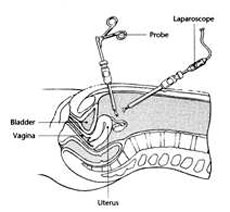Laparoscopy
 A laparoscopy is a minor outpatient surgical procedure that involves placing a small telescope-like instrument through a small incision near the belly button. Frequently a 2nd or 3rd incision is made in the pubic area to allow further manipulation of the pelvis with additional instruments. The abdomen is filled up with gas so that pelvic structures can be seen.
A laparoscopy is a minor outpatient surgical procedure that involves placing a small telescope-like instrument through a small incision near the belly button. Frequently a 2nd or 3rd incision is made in the pubic area to allow further manipulation of the pelvis with additional instruments. The abdomen is filled up with gas so that pelvic structures can be seen.
The purpose of the laparoscopy is to visualize the pelvic structures as part of an evaluation for infertility, pelvic adhesions, endometriosis, pelvic pain and other gynecologic problems.
At time of laparoscopy, a laser or electrocautery may be used to treat any abnormal findings. Patency of the fallopian tubes can be determined as well. Not all gynecologic problems are treatable with the laparoscope. If endometriosis or adhesions are present and treated, there is a recurrence rate of about 50% with each of these conditions.
A laparoscopy is a very safe procedure but some complications do occur. Risks of this surgery include bleeding, infection (2-4%), risks of anesthesia, risk of injury to internal organs or structures which may require more extensive surgery (1 chance in 500).
